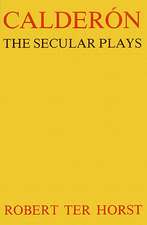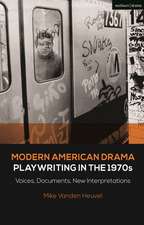Studying Plays
Autor Dr Mick Wallis, Simon Shepherden Limba Engleză Paperback – 24 ian 2018
| Toate formatele și edițiile | Preț | Express |
|---|---|---|
| Paperback (1) | 147.69 lei 6-8 săpt. | +47.31 lei 4-10 zile |
| Bloomsbury Publishing – 24 ian 2018 | 147.69 lei 6-8 săpt. | +47.31 lei 4-10 zile |
| Hardback (1) | 468.15 lei 6-8 săpt. | |
| Bloomsbury Publishing – 24 ian 2018 | 468.15 lei 6-8 săpt. |
Preț: 147.69 lei
Preț vechi: 180.16 lei
-18% Nou
Puncte Express: 222
Preț estimativ în valută:
28.26€ • 29.40$ • 23.33£
28.26€ • 29.40$ • 23.33£
Carte tipărită la comandă
Livrare economică 15-29 aprilie
Livrare express 08-14 martie pentru 57.30 lei
Preluare comenzi: 021 569.72.76
Specificații
ISBN-13: 9781350007321
ISBN-10: 1350007323
Pagini: 248
Dimensiuni: 156 x 234 x 18 mm
Greutate: 0.39 kg
Ediția:4
Editura: Bloomsbury Publishing
Colecția Bloomsbury Academic
Locul publicării:London, United Kingdom
ISBN-10: 1350007323
Pagini: 248
Dimensiuni: 156 x 234 x 18 mm
Greutate: 0.39 kg
Ediția:4
Editura: Bloomsbury Publishing
Colecția Bloomsbury Academic
Locul publicării:London, United Kingdom
Caracteristici
Includes updated references including the latest plays of Caryl Churchill, verbatim theatre such as the Tricycle's Stephen Lawrence Inquiry and multi-media plays
Notă biografică
Mick Wallis is Professor Emeritus of Performance and Culture at the University of Leeds, UK. He is co-author (with Simon Shepherd) of Drama/Theatre/Performance (2004).Simon Shepherd is Professor Emeritus of Theatre at Royal Central School of Speech and Drama, University of London, UK. He is the author of The Cambridge Introduction to Performance Theory (2016) and Modern British Theatre (2010) and co-author with Mick Wallis of Drama/Theatre/Performance (2004).
Cuprins
Acknowledgements Introduction 1. Getting Started 2. Characters and Persons 3. Dialogue 4. Plot and Action 5. The Actor's Body 6. Spaces7. Dealing with Some New Kinds of Text 8. Culture and Interpretation Glossary Bibliography Index
Recenzii
A highly usable resource for text analysis and addressing plays. However, it is so much more than this and I suggest that it be considered as a seminal textbook ... As well as the detailed attention to play extracts and the highly useable frameworks within which to address the scripted play, this seminal text skilfully locates the understanding of the dramatic script within socio-political historical contexts ... A trusted text given a welcome spruce up.
This newly revised classic, now with a much-needed section on the postdramatic, will grace the studio as much as the seminar room, empowering the next generation of students to talk about plays with genuine precision and insight.
Studying Plays attends to the diverse critical practices essential to the multidisciplinary study of drama. Ranging across formal elements of drama to bodies, space, and the cultures of performance, it suggestively engages undergraduates, instructors, and a wider audience.
The durability of this excellent book confirms the importance of comprehensive and detailed methodical explanations of how drama works and becomes theatre. Essential reading for all young practitioners and students.
Studying Plays offers a model of diversity in terms of the examples it draws on from a range of periods and genres, but also in terms of the race, gender and sexuality of those who made the work discussed. That it does so without compromising the depth and rigour of the analysis is a testament to the skill and commitment of the authors. The combination of breadth, depth and rigour makes it a book that students and their tutors can return to again and again.
This newly revised classic, now with a much-needed section on the postdramatic, will grace the studio as much as the seminar room, empowering the next generation of students to talk about plays with genuine precision and insight.
Studying Plays attends to the diverse critical practices essential to the multidisciplinary study of drama. Ranging across formal elements of drama to bodies, space, and the cultures of performance, it suggestively engages undergraduates, instructors, and a wider audience.
The durability of this excellent book confirms the importance of comprehensive and detailed methodical explanations of how drama works and becomes theatre. Essential reading for all young practitioners and students.
Studying Plays offers a model of diversity in terms of the examples it draws on from a range of periods and genres, but also in terms of the race, gender and sexuality of those who made the work discussed. That it does so without compromising the depth and rigour of the analysis is a testament to the skill and commitment of the authors. The combination of breadth, depth and rigour makes it a book that students and their tutors can return to again and again.



















